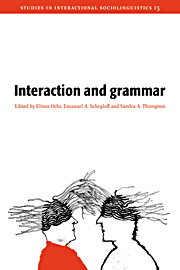Book contents
- Frontmatter
- Contents
- Notes on the contributors
- 1 Introduction
- 2 Turn organization: one intersection of grammar and interaction
- 3 Interactional units in conversation: syntactic, intonational, and pragmatic resources for the management of turns
- 4 Resources and repair: a cross-linguistic study of syntax and repair
- 5 On the “semi-permeable” character of grammatical units in conversation: conditional entry into the turn space of another speaker
- 6 On repeats and responses in Finnish conversations
- 7 “When I come down I'm in the domain state”: grammar and graphic representation in the interpretive activity of physicists
- 8 Transparent vision
- 9 Conversational signifying: grammar and indirectness among African American women
- 10 Creating evidence: making sense of written words in Bosavi
- Appendix Transcription conventions
- Index
5 - On the “semi-permeable” character of grammatical units in conversation: conditional entry into the turn space of another speaker
Published online by Cambridge University Press: 14 January 2010
- Frontmatter
- Contents
- Notes on the contributors
- 1 Introduction
- 2 Turn organization: one intersection of grammar and interaction
- 3 Interactional units in conversation: syntactic, intonational, and pragmatic resources for the management of turns
- 4 Resources and repair: a cross-linguistic study of syntax and repair
- 5 On the “semi-permeable” character of grammatical units in conversation: conditional entry into the turn space of another speaker
- 6 On repeats and responses in Finnish conversations
- 7 “When I come down I'm in the domain state”: grammar and graphic representation in the interpretive activity of physicists
- 8 Transparent vision
- 9 Conversational signifying: grammar and indirectness among African American women
- 10 Creating evidence: making sense of written words in Bosavi
- Appendix Transcription conventions
- Index
Summary
In dialogue, the lines of the individual participants are grammatically disconnected; they are not integrated into one unified context. Indeed, how could they be?
V. N. Volosinov, Marxism and the Philosophy of Language (p. 116).Language structure has long been described in isolation from its natural home of talk-in-interaction. Some have even made this a research policy. On the other hand, a central concern of those disciplines that study speech has been to describe its function. For the most part grammar and particularly syntactic structure has been ceded to those who study language as a self-contained system. However, grammatical structure is not merely an artifact of linguistic inquiry that has isolated language form from its actualization as talk-in-interaction. Features of talk-in-interaction are structured by their producers, and an orientation to the structure of various features of talk-in-interaction can be seen in the ways participants treat various aspects of talk. Two prominent examples are the structuring of talk as turn-constructional units (Sacks, Schegloff, and Jefferson, 1974; Schegloff, this volume) – henceforth TCUs – and the further structuring of some turns at talk into “preferred” and “dispreferred” turn shapes (Sacks, 1987 [1973]; Pomerantz, 1984). Turns at talk are designed for (and as a part of) practical action in interaction. The structures of talk-in-interaction are social structures of practical actors, and the features of their talk then are features of practical action.
- Type
- Chapter
- Information
- Interaction and Grammar , pp. 238 - 276Publisher: Cambridge University PressPrint publication year: 1996
- 229
- Cited by

